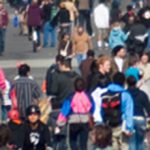Market Street Traffic Safety Plan Approved, Uber Balks
Wednesday, June 17 – Bay City News, Sara Gaiser
The San Francisco Municipal Transportation Agency board Tuesday unanimously approved a plan to prohibit private vehicles from turning on to a busy section of Market Street in an effort to make the area safer for pedestrians and bicyclists and improve the flow of public transit.
The Safer Market Street plan would ban turns on to Market between Third and Eighth Streets for private vehicles but allow them for public transit, bicycles, taxis, commercial and emergency vehicles, according to SFMTA officials.
In addition, it would establish new passenger loading zones and disabled parking areas north and south of Market Street, extend transit-only lanes all the way to Third Street and create new bulb-outs at several intersections.
The plan drew strong support from groups including the San Francisco Bicycle Coalition, Walk SF and city taxi drivers, but was vocally opposed by ride-booking service Uber. The company last week rallied its passengers and drivers to sign a petition calling for further study of the proposal and Tuesday said it had gathered 17,000 signatures.
Wayne Ting, general manager for Uber San Francisco, told the SFMTA board that Uber was a “strong supporter” of San Francisco’s Vision Zero plan, which calls for eliminating pedestrian deaths by 2024. However, he argued that the plan was unfair because it gave taxis “preferential treatment” over ride-booking service vehicles, which do not carry commercial licenses.
Drawing several hisses from audience members, Ting said:
“If right turns on to Market Street are making Market Street less safe, then no vehicles should have the opportunity to make those turns.”
His concerns were rejected by a number of speakers, however, who noted that Uber has actively fought to avoid being licensed and regulated in the same manner as taxis in other circumstances.
Nicole Ferrara, executive director of Walk SF, said before Tuesday’s meeting:
“If Uber wants to be regulated like a taxi then they can have the benefits of being regulated.”
Ferrara noted that another ride-booking service, Lyft, had expressed support for the Safer Market Street plan. However a Lyft spokeswoman speaking at today’s meeting also spoke in favor of “consistent treatment” of for-hire vehicles.
The area affected by the new restrictions is home to four of the city’s top 20 most dangerous intersections for pedestrians and the top two for bicyclists, according to SFMTA staff. A total of 162 injury collisions occurred between Eighth and Third streets between 2012 and 2013, nearly 60 percent of which involved a person walking or biking who was struck by a car, officials said.
Tom Maguire, director of sustainable streets for the SFMTA, said:
“The kinds of crashes happening on Market Street are largely caused by vehicles making turns. … The only way to reduce these collisions is to reduce dramatically the number of vehicles who are making turns.”
A survey conducted by the SFMTA in 2014 found that 84 percent of people on Market Street had arrived by means other than a private vehicle, and even those who did use a private vehicle didn’t drive on Market Street.
SFMTA staff estimate the plan could divert 30 to 50 percent of vehicles off of Market Street, creating a 3 to 5 percent increase in traffic on neighboring streets.
Noah Budnick, executive director of the San Francisco Bicycle Coalition, said:
“These improvements are a step in the right direction for the safety and comfort of everyone who uses Market St. …. SFMTA’s research found a crowded and dangerous corridor, and they identified a solution to improve safety while reducing congestion. It’s a win-win for San Francisco.”


